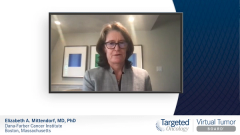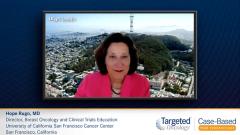
IMpassion130 and KEYNOTE-355 Trials in Patients With Metastatic TNBC: Part 1
An expert in breast oncology discusses the IMpassion130 and KEYNOTE-355 clinical trials.
Episodes in this series

Hope Rugo, MD: This patient actually meets the criteria for IMpassion130 perfectly. Patients who were eligible for IMpassion130 had to be at least 1 year out from their treatment given in the curative setting. This patient is 13 months out. The reason why that criterion was used for patients who were enrolled in IMpassion130 is that we chose to use a taxane backbone of chemotherapy. We wanted to make sure patients did not have disease that was inherently resistant to up-front taxane therapy. We chose nab-paclitaxel as the chemotherapy partner to avoid using steroids as a premedication, potentially abrogating the immune effect. IMpassion130 randomized patients like this 1 regardless of PD-L1 status but stratified by PD-L1 status to receive nab-paclitaxel and placebo or nab-paclitaxel and the checkpoint inhibitor, atezolizumab. Nab-paclitaxel was given in a 3 weeks on, 1 week off schedule, which made the scheduling with atezolizumab and coordination complicated but doable for patients.
The patient by PD-L1 testing is clearly eligible based on the IMpassion130 trial. What did the trial show? We talked about this a little already. We saw a statistically significant improvement in progression-free survival [PFS] with the addition of atezolizumab in the patient cohort who had tumors positive for PD-L1 defined as having SP142 staining in tumor of 1% or greater. A fairly small number of patients had liver biopsies that determined their eligibility in IMpassion130. It didn’t matter whether the tumor that determined eligibility by SP142 positivity was obtained from an early stage or late-stage lesion. Interestingly, most tumors were obtained a median of 60 days before treatment started, and most of these were de novo metastatic lesions or metastatic tumor biopsies after an early stage diagnosis.
IMpassion130 also looked at the intent-to-treat population in patients who had PD-L1–negative disease and showed that there was not a benefit in the PD-L1–negative subpopulation. We also looked at data recently published by Leisha Emens on whether it made a difference how intense the SP142 staining was. It didn’t make a difference. Patients responded to treatment with an improved PFS and OS [overall survival] regardless of whether there was intense or minimal SP142 positivity for PD-L1. Additionally, having BRCA1 or BRCA2 mutation didn’t make a difference. PD-L1 positivity was the best predictor of response to atezolizumab; better than tumor infiltrating lymphocytes or CD8 positivity.
This patient is an excellent candidate for the treatment. Treatments are particularly appealing for triple-negative breast cancer in any setting if we can improve survival, our gold standard. That’s a great option for this patient and was the treatment she received. What if the patient had relapsed earlier, like less than 12 months after completing her adjuvant treatment? In that case, if she was disease-positive for PD-L1 using the 22C3 antibody and CPS [combined positive score], a scoring system, with a score of at least 10, she would have been eligible for pembrolizumab and chemotherapy as her first-line treatment based on data from the KEYNOTE-355 trial. In that trial, patients were eligible if they had recurred at least 6 months out from their last treatment with curative intent. The chemotherapy options include gemcitabine and carboplatin, which about half the patients received, and paclitaxel or nab-paclitaxel. More patients received nab-paclitaxel than paclitaxel. As I mentioned, progression-free survival was improved by a little more than 4 months in patients who had PD-L1–positive disease defined as this score of 10 or greater. Patients benefited regardless of the chemotherapy backbone, although it appeared that patients had a better improvement in their outcome if they received a taxane, compared with gemcitabine and carboplatin, and if they had de novo metastatic disease. And this is just an indicator of resistance. Similar data have been seen in IMpassion130. Patients who were farther out from their last taxane or hadn’t received a taxane at all seemed to have a better outcome with the steady treatment.
Transcript edited for clarity.












































